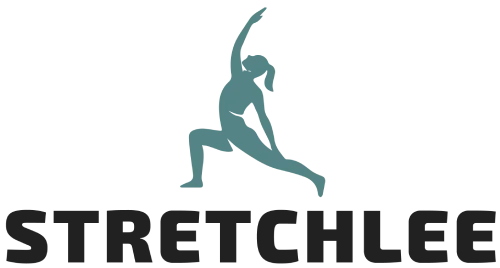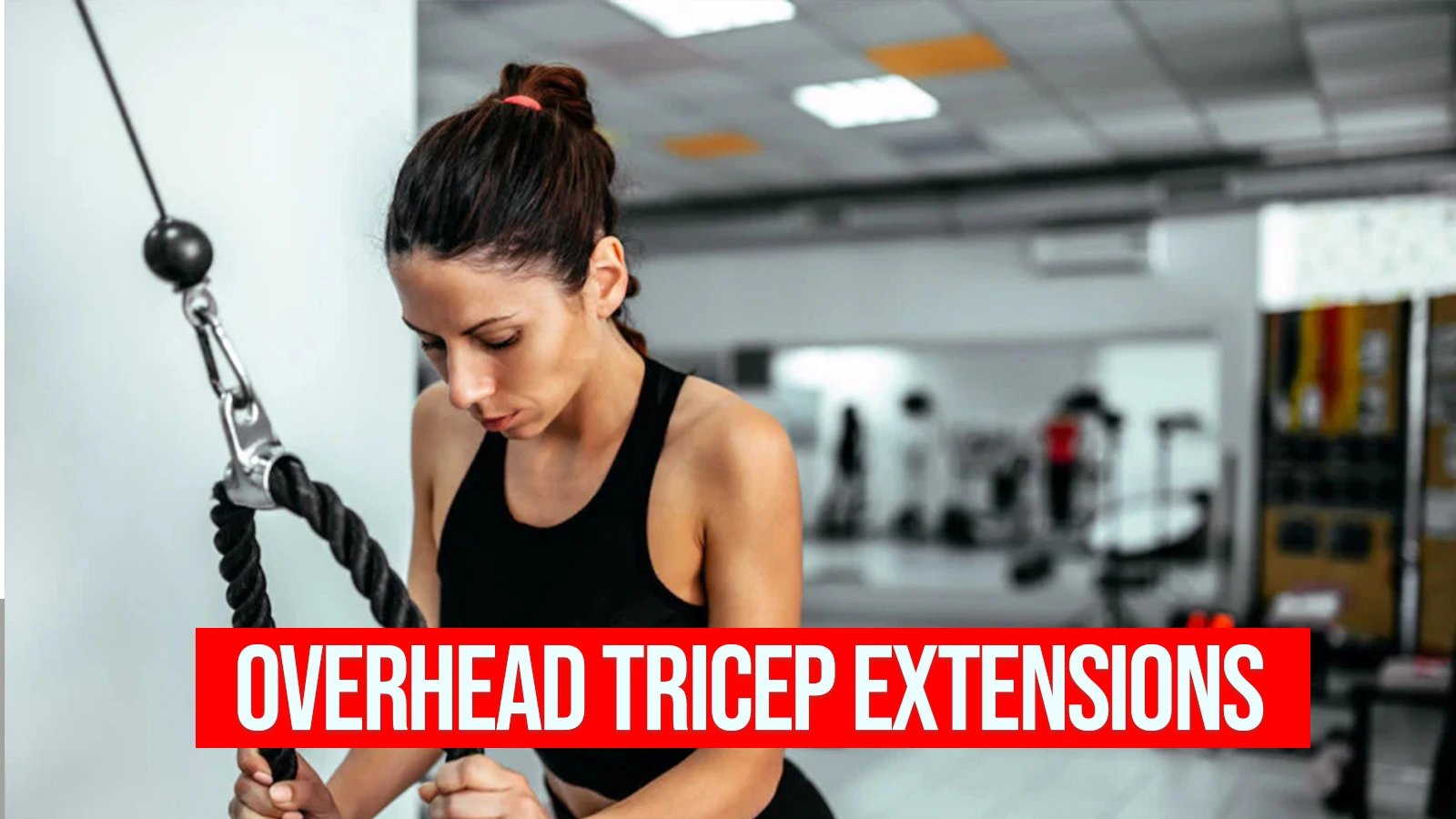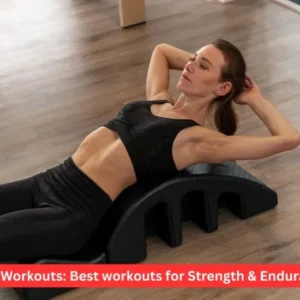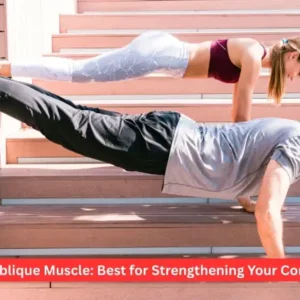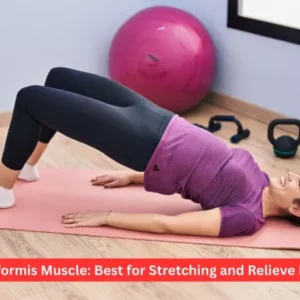The triceps major purpose is to extend the elbow, which moves the forearm away from the upper arm. The overhead tricep extension trains this action in an overhead posture, focusing on all heads of the triceps with a special emphasis on the long head and helping to build shoulder stability.
The overhead tricep extension is often performed with dumbbells and can be done unilaterally or bilaterally. The cable machine can also be utilized for this activity. It can be an excellent technique to increase the difficulty because it applies consistent strain to the muscles and emphasizes the eccentric phase of the movement, which is often overlooked. We’ve discussed both alternatives below.
What is the triceps muscle? (Short Overview)
The triceps brachii is a three-headed muscle that has two basic functions.
The initial step is to extend or straighten the elbow. The second is assisting in pulling the arm down from an overhead or front-of-body posture (shoulder extension). Furthermore, the triceps play a vital role in stabilizing shoulder joints.
The muscle begins at the rear of the scapula and on the back of the upper arm bone, known as the humerus. It spans the length of the upper arm’s back before attaching to the elbow’s tip, known as the olecranon process of the ulna.
The triceps consist of three heads: medial, lateral, and long. The long head is the most important during overhead tricep presses.
How to do overhead tricep extension
The most frequent method for performing this exercise is to stand or sit while holding a dumbbell (or kettlebell). Hold the weight aloft by holding both handles of the kettlebell or the inside surface of the dumbbell plate.
Slowly bend your elbows and lower the weight behind your head as far as possible. Remember to maintain an erect posture and activate your core. Your weight should follow the path of your spine.
Then, at the lowest point, straighten your elbows and return the weight overhead. Hold the fully extended position for a time before repeating. Keep your movements slow and controlled.
Choose a weight that is demanding yet allows you to maintain proper form. Keep the movement slow and steady.
How it compares with other tricep exercises
The overhead tricep extension is similar to a tricep pulldown with elbows at the sides.
A recent study examined the two exercises and discovered equivalent activation of the tricep muscles throughout the raising and lowering stages (concentric and eccentric motions, respectively).
However, the overhead tricep extension works the triceps in their maximum extended position.
The triceps muscles attach above the shoulder and below the elbow joint. Thus, in the overhead tricep workout, when the weight is at its lowest position, your triceps are stretched to their full length.
Additionally, your shoulder and core muscles serve as stabilizers throughout this action. Because your arms are raised overhead, greater steadiness against gravity is required than in other workouts. This may make the workout seem more difficult than executing tricep pulldowns.
This exercise is distinct from the dip and bench press exercises, which are compound motions. This indicates that they use many muscles at more than one joint. The tricep extension is an individual exercise that targets the triceps primarily at the elbow joint.
Considerations when doing overhead tricep extensions
Depending on the sort of resistance you employ (dumbbell, kettlebell, band, etc.), the most challenging portion can be getting the weight into position. Use a weight that permits you to return to your starting position safely.
Focus on your form by moving slowly and avoiding momentum.
Finally, keep your trunk stable while lowering the weight behind your back and down your spine. If the weight is too heavy or you’re tired, you may be inclined to arch your back, which puts additional strain on your back and shoulder joints.
Variations of the overhead tricep extension
As previously stated, you can perform this exercise seated.
It can also be done with a dumbbell in one hand. The weight will move at a slightly different angle in this situation. You can also use the opposite hand to keep your upper arm stable while you complete the exercise.
You may also do this workout by substituting bands for the resistance. If the band is long enough, you can stand on the band or attach it to anything, such as a door handle. It’s worth noting that doing this significantly alters the angle, so it feels different.
The workout can also be done with a cable machine. Be careful when you modify the cable pulley’s height so that it doesn’t have to travel as far to the overhead position.
Adjusting the pulley height to half or three-fourths of your height (rather than lower) makes it easier to lift the weight overhead and return to the starting position.
How To Do A Dumbbell Overhead Tricep Extension
- Take a shoulder-width stance while holding the end of a dumbbell in both hands. If you’re holding a dumbbell in each hand, grab the handle.
- Brace your stomach and move your belly button closer to your pelvis to engage your core muscles
- Lift the dumbbell above your head with your arms extended and palms toward the ceiling.
- Begin the repetitions by bending at the elbow and lowering the dumbbell behind your head. Allow your forearms to move while keeping your upper arms still.
- Once you’ve lowered the dumbbell as far as possible, squeeze your triceps to stretch your arms and return the weight to its starting position.
How To Do A Cable Overhead Tricep Extension
- Set up a cable machine with the pulley at head height and attach a rope grip.
- Cup each end of the rope with both hands, pivot away from the cable machine, take a shoulder-width stance, and stagger your feet. Allow your arms to extend above and forward of your head.
- Brace your stomach and move your belly button closer to your pelvis to engage your core muscles.
- Begin the reps by bending your elbow and lowering the rope behind your head toward the cable machine. Keep your upper arms stationary, allowing only your forearms to move.
- Squeeze your triceps while extending your arms and returning the rope hold to its starting position.
Conclusion
The overhead tricep extension is an excellent workout for the triceps. It’s similar to doing tricep extensions with your elbows by your sides. Both variations isolate the triceps well.
It is also an excellent approach to improving shoulder and core stability, which can reduce the chance of harm.
Tricep extensions are an excellent way to add diversity to your routine if you normally perform tricep pulldowns or kickbacks. Enjoy—and, if possible, create a funny comment for the triceps.
FAQ’s
Are Overhead Tricep Extensions Good?
The overhead tricep extension is an excellent exercise for targeting all three heads of the triceps while also improving shoulder and core stability.
Are Overhead Tricep Extensions Bad For Elbows?
Overhead tricep extensions are not intrinsically harmful to elbows; nonetheless, it is critical to utilize a weight that allows you to do the action controlled and with good form, as poor technique can stress the elbow. Repeatedly locking out or hyperextending the elbows can cause pain, so try to straighten your arms, but avoid locking the elbows.
What Does The Cable Overhead Tricep Extension Work?
The cable form of this exercise targets the triceps, specifically the long head of the muscle. The shoulders, core, and glutes are all engaged to help stabilize this movement.
